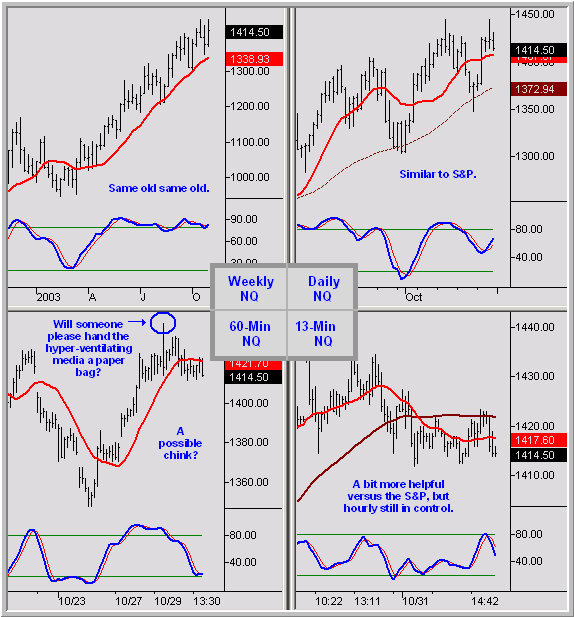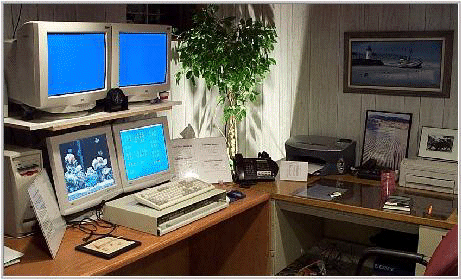This May Provide Fuel For The Bears On Monday
Both major markets finished in
the light-green this week, with ES
gaining 18 and NQ tacking on 38. Friday was pretty much a non-event as traders
and fund managers seemed content to let October settle without a bang, although
some late-day weakness did creep in, especially on the technology side. More on
that in a moment.
It’s always a challenge trading during earnings week unless one is active in the
overnight Globex market, which continues to be a necessity from time to time to
capitalize on opportunities when presented vs. when one would like them
presented. Such has been the case over the last few weeks where some of the
major triggers have occurred overnight, although Thursday provided an abundance
of intraday opportunities, thanks to one of the all-time gap traps into an
overbought market — thank you, hyperventilating media and “new bull market”
sirens.
From an intraday pace perspective, the hourly pattern has been among the better
timeframes in play, with intermediate shorts going nowhere until it breaks. The
Nasdaq did show some relative price weakness on Friday, and for the first time
in a while, lagged the broader market which may be worth watching into next
week. The weak Friday close and VIX probe above its 13-minute 15MA in the final
30 minutes of trading may also provide fuel for the bears on Monday.
Let’s hit the charts and then talk a little about my thoughts on trading station
redundancy.
S&P 500

Nasdaq

Moving Avg
Legend: 15MA
Larger Timeframe 15MA
See https://www.donmillertrading.com
for Setups and Methodologies
Charts © 2003 Tradestation
Back to Work
First, I’d like to add my welcome to two
traders who recently joined TM … the first is admittedly very belated and is to
Chris Curran, who is among those I trade alongside every day. Sorry for the
delayed welcome, Chris! The second is to Rick Burgess, whose early columns
I’ve thoroughly enjoyed. It’s always a pleasure for me to read realistic views
of this business from real “grinders” amidst the rampant ego and hype, and I
look forward to reading more of their insights in the future.
Second, it’s nice to be back at the
column after spending two weeks in Red Sox de-tox, alongside the rest of New
England. I’m now back on solid foods and can even laugh (OK, it’s more of a
grinding-teeth smirk) at the growing list of Grady Little jokes which include my
two favorites: What was wrong with Grady’s broken lawnmower? Nothing, he just
forgot to pull the starter; and: What do Little and Don Zimmer have in
common? They both couldn’t take out Pedro. Thank goodness for tomorrows and
winter sports.
Anyway, back to work. I thought it would be helpful to use this weekend’s piece
to touch on one of the critical elements of my — or perhaps more appropriately,
“any” — trading station setup. The layout is pretty much the same as presented
in the E-Mini video and course, and I’ve snapped a photo of my current office
layout to get started:

The critical theme
of the station is best described as redundancy. Two CPUs (one hidden under the
tree), two chart feeds, two ISP connections from two separate vendors, three
brokers (one primary and two back-up, which combined with the chart feeds
provides five sources for quotes), two phone lines, and a continual link to peer
traders. About the only element that doesn’t reflect redundancy is the single
rake in the Zen garden.
And while the setup is modest in comparison to a 50-station trading floor, I
know of too many “serious” traders (who are not constricted by
under-capitalization) trying to trade on a single CPU with a single broker. Now
I’m not talking about part-time or hobby traders where a single source is less
of an issue, or for those trading daily or weekly charts where immediate price
and one-minute charts are irrelevant, rather I’m addressing those who commit
sufficient time, capital, and energy throughout every trading day where loss of
data — whether it be one-time or intermittent — or the ability to execute can
make a critical difference in terms of opportunity or financial cost. Been
there, done that.
Sure, the setup results in a doubled cost of infrastructure, yet in a business
where overhead costs are at the bargain basement end of most industries, as most
of our costs — specifically, commissions — are variable, the added fixed
insurance cost is minimal.
Now for the disclaimer, while no doubt obvious for many is still worth
mentioning: A strong trading station doesn’t make a strong trader, nor does any
technical setup, method, service, or guru. Yet like a good baseball manager, it
can make the difference between being five outs away from paradise and a painful
opportunity gone by the boards.
Good Trading and Have a Great
Weekend!
